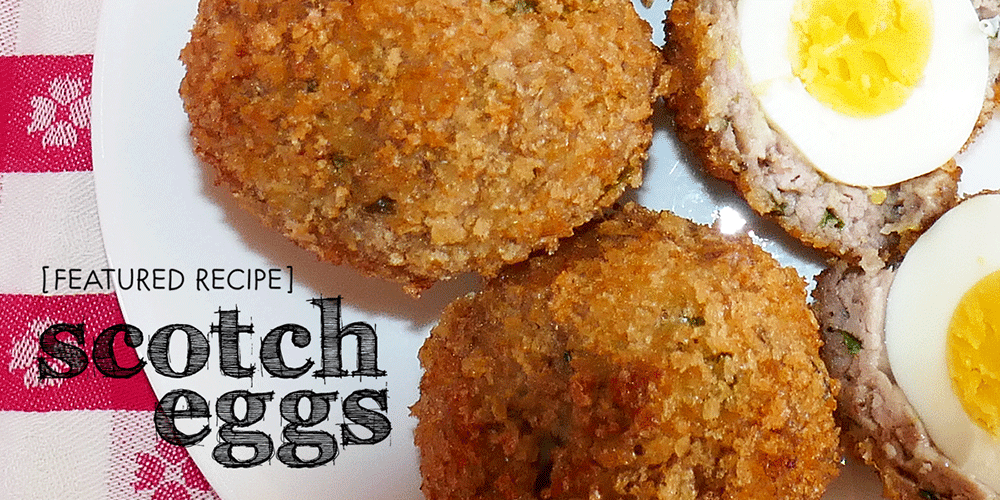Dig into the history of English picnicking, and two of the first things you encounter are Scotch eggs and pork pies. We weren’t quite ready to tackle pork pies, so we went with the odd but intriguing Scotch eggs instead.
They’re pretty simple, so you could treat them as just one more thing to throw into the fryer, but why bother? Their simplicity is exactly what allows you to use them as a springboard for your imagination, and we’re pretty happy with the little variation we concocted here.
—Rachel
Ingredients
- 4 small to medium eggs for boiling
- 1 egg to be beaten for coating
- 3 links pork sausage
- 1 tbsp parsley, finely chopped
- 2 tsp thyme
- 2 scallions—the meatiest part, finely diced
- 1/3 cup shredded white cheddar cheese (altho a touch more can’t hurt)*
- sea salt
- fresh-ground pepper
- 1/2 cup panko breadcrumbs
- 1/2 cup flour (enough to cover a plate) for dredging
- 48 oz vegetable oil (quantity depends on the size of your pan)
* I urge you to use a good artisan cheese, like the white cheddar from First Light Creamery. It does make a big difference.

Directions
Put four small eggs* into a pot of cold salted water, bring it to a boil, then let the eggs simmer for 8 minutes.**
Remove the eggs from the water with a slotted spoon, plunge them into a bowl of ice water, remove the eggs, lightly tap the ends of each egg to crack them, then peel & set aside.
Remove the casing from the sausage links, put the meat into a bowl, and work in the parsley, sage, scallions & shredded white-cheddar cheese until thoroughly blended with the meat. Season with sea salt & a generous amount of fresh-ground pepper.
Divide the ball of sausage meat into 4 equal sections & use your palm to press each section as flat as possible into an oval about 5” high & 4” wide.
Dredge each egg in a plate of flour. (Some recipes call for seasoning the flour with sea salt & fresh-ground pepper. That could be useful, but it’s probably not necessary if you’ve adequately seasoned the meat.)
Place an egg in the center of each oval of sausage meat and then wrap the meat until it completely covers the egg. (Pull away any excess meat. While you want the eggs to be covered, you also want the layer to be as thin as possible.)
Beat an egg in a bowl, dip each wrapped egg in the beaten egg, then cover each one completely with panko breadcrumbs. (You want to cover the meat with breadcrumbs but, as with the meat layer, you also want to make the layer as thin as possible, to avoid making the eggs too bulky and the flavor too bready.***)
Heat enough vegetable oil to cover the eggs until it’s hot enough to make a breadcrumb sizzle. (Medium to just a touch more seems to work well.) Carefully place the eggs in the oil & fry them for about 8 minutes, until they’re crispy & golden brown.*****
Use a slotted spoon to remove the eggs from the oil then place them on a plate covered with paper towel to dry.
Serve cool. A dipping sauce is a nice side, but the stone-ground mustard favored by the British got a consistent thumbs-down from our panel of taste-testers. It seems kind of lazy to just pour some ranch dressing into a bowl. Something like a cucumber dill sauce seems like it might make a nice counterpoint—both culinarily (if there is such a word) and culturally—but we didn’t get a chance to whip one up in time for deadline.
—Chef Jean-Luc Bataille
* We learned the hard way that you want to use the smallest eggs you can. Otherwise you end up with something the size of a bocci ball, which goes against the whole tradition of wrapping these up and stuffing them in your pockets or bag for your picnic foray into the countryside.
Also, larger eggs can make the final product excessively eggy. You want to strike a flavor balance between the breadcrumbs, sausage, and eggs.
** The English seem to prefer a slightly runny yolk, and having taken a couple stabs now at making these, I can see merit in that idea. With the crunchiness of the breading & the flavor burst of the seasoned meat, a soft yolk can become another part of the sensual experience of consuming the egg.
*** Panko breadcrumbs really do the trick here because they help keep the eggs light & make the final product nice & crispy. Regular breadcrumbs seem to need an excessive amount to cover the eggs completely, resulting in something indistinguishable from a mass-market hush puppy or jalapeño popper.
**** Yes, another footnote: Use your own judgment with this step because stoves vary so much. Scotch eggs lose a lot of flavor once they get too brown, so you want to remove them once they’ve attained that consistent golden color, while also making sure they’ve been fried for at least 6 minutes, to ensure the sausage is properly cooked.

